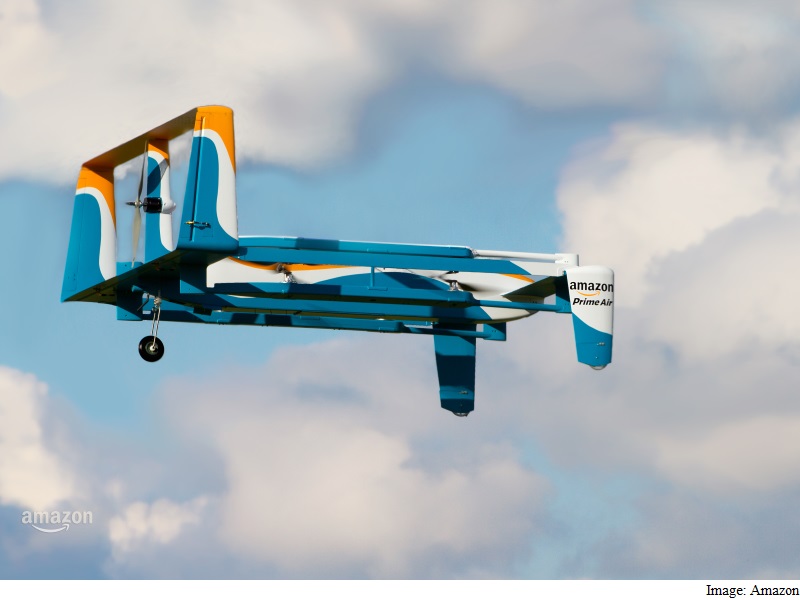- Home
- Internet
- Internet News
- Amazon Video Shows Off New Delivery Drone Prototype
Amazon Video Shows Off New Delivery Drone Prototype

Amazon's prototype is an octocopter - meaning it has eight propellers and can take off and land vertically, like a helicopter. But the design also includes wings and a "pusher motor" so that it can transition from helicopter takeoffs to the energy-efficient flight of a plane at altitude. A pure octocopter wouldn't be capable of a range of 15 miles, like this prototype.
At altitude, only the pusher motor - the large propeller in the back of the drone - is in motion. The eight other propellers reactivate once the drone is about to land and needs to make a vertical descent into a yard.
A promotional video shows the drone switching into "landing mode" and descending onto a "delivery zone" in the customer's backyard. The drone releases the package onto what looks like a sheet of plastic with an Amazon logo. The larger the yard and the less tree cover, the easier the landing will be.
Just like in its first drone video, the Amazon drone lands to drop off a package. This is a different tactic than what rival Google has demonstrated, in which its hovering drone releases a package that floats to the ground.
Amazon (whose founder and chief executive, Jeffrey P. Bezos, owns The Washington Post) will need to be certain its drone can land in a backyard without any mishaps involving a family pet, kids, stray sports equipment, a new birdbath or whatever else might be in a yard.
Amazon says its drone has "sophisticated 'sense and avoid' technology," which will be essential for those backyard landings. Everyone from big tech companies such as Amazon to start-ups is developing this technology, so that drones can identify obstacles and automatically avoid them. For example, with sense and avoid, a drone would realize a dog had strayed into its landing zone, and not land until the coast was clear.
One section of the video, which Amazon notes is actual flight footage, shows the drone flying between 55-58 mph. That speed will come in handy if Amazon is going to deliver on its promise of getting packages to customers in 30 minutes.
The company isn't saying how much this prototype weighs, only that its drones weigh less than 55 pounds. And it's not sharing the prototype's wingspan. Judging by the size of the shoe box it delivers in the video, it's obvious the drone is far larger than the consumer drones we see most frequently, such as the DJI Phantom and Parrot Bebop.
A larger drone means Amazon can carry larger packages. Larger drones are generally heavier, which increases risk in the event of a crash. At the same time, all that size creates space for nine propellers (eight for vertical movement, one for horizontal) - meaning it has more back-up propellers than a typical drone with four propellers, which improves safety.
Don't expect an exact replica of this drone to eventually land in your backyard. Amazon says it has more than a dozen prototypes in its research and development labs, and that the characteristics will continue to evolve.
It may be significant that the video is narrated by a Brit - former Top Gear host Jeremy Clarkson, who is developing a show for Amazon. The company has taken its testing overseas given its frustration with the slog toward commercial drone regulation in the United States. Amazon says it will launch Prime Air once it has regulatory support. Don't be surprised if it launches first outside the United States.
Amazon says the prototype can operate safely "beyond line of sight" to distances of 10 miles or more. That means outside the view of the person responsible for controlling it. However the FAA's proposed commercial drone rules, released in February, require drones to fly where the drone's pilot can see it. While U.S. drones may eventually be able to fly out of sight, the process isn't moving as fast as Amazon would like.
© 2015 The Washington Post
Catch the latest from the Consumer Electronics Show on Gadgets 360, at our CES 2026 hub.
Related Stories
- Samsung Galaxy Unpacked 2025
- ChatGPT
- Redmi Note 14 Pro+
- iPhone 16
- Apple Vision Pro
- Oneplus 12
- OnePlus Nord CE 3 Lite 5G
- iPhone 13
- Xiaomi 14 Pro
- Oppo Find N3
- Tecno Spark Go (2023)
- Realme V30
- Best Phones Under 25000
- Samsung Galaxy S24 Series
- Cryptocurrency
- iQoo 12
- Samsung Galaxy S24 Ultra
- Giottus
- Samsung Galaxy Z Flip 5
- Apple 'Scary Fast'
- Housefull 5
- GoPro Hero 12 Black Review
- Invincible Season 2
- JioGlass
- HD Ready TV
- Laptop Under 50000
- Smartwatch Under 10000
- Latest Mobile Phones
- Compare Phones
- OPPO Reno 15 Pro Max
- Honor Win RT
- Honor Win
- Xiaomi 17 Ultra Leica Edition
- Xiaomi 17 Ultra
- Huawei Nova 15
- Huawei Nova 15 Pro
- Huawei Nova 15 Ultra
- Asus ProArt P16
- MacBook Pro 14-inch (M5, 2025)
- OPPO Pad Air 5
- Huawei MatePad 11.5 (2026)
- Xiaomi Watch 5
- Huawei Watch 10th Anniversary Edition
- Acerpure Nitro Z Series 100-inch QLED TV
- Samsung 43 Inch LED Ultra HD (4K) Smart TV (UA43UE81AFULXL)
- Asus ROG Ally
- Nintendo Switch Lite
- Haier 1.6 Ton 5 Star Inverter Split AC (HSU19G-MZAID5BN-INV)
- Haier 1.6 Ton 5 Star Inverter Split AC (HSU19G-MZAIM5BN-INV)

















